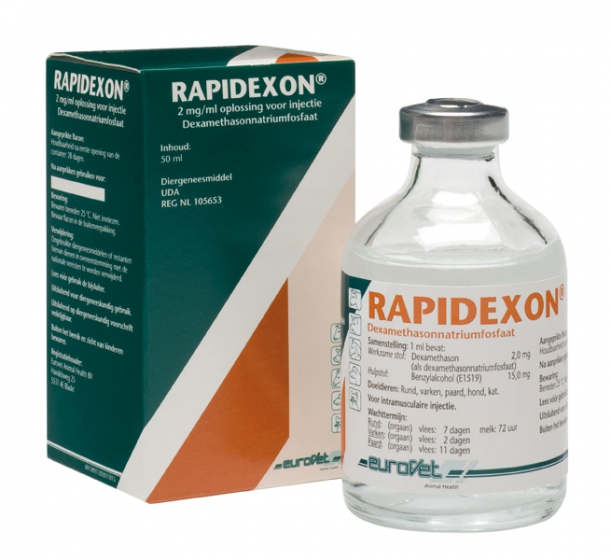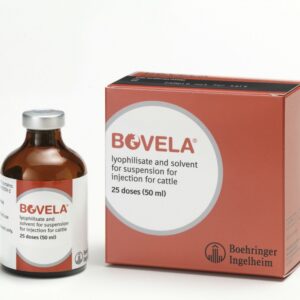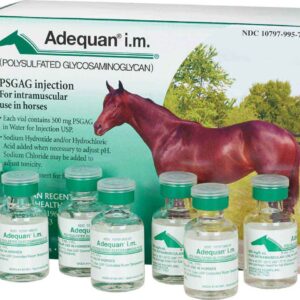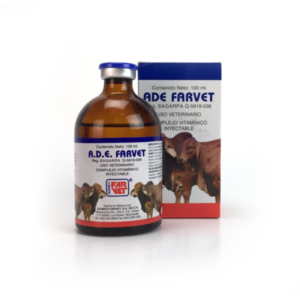RAPIDEXON Indications: Inflammatory and allergic procedures, primary ketosis, and induction of labor.
Pharmacodynamic properties: This preparation contains the sodium phosphate ester of dexamethasone, a fluoromethyl derivative of prednisolone, which can be a potent glucocorticoid with minimal mineralocorticoid action. Glucocorticoids act on metabolism by increasing gluconeogenesis.
Interactions and incompatibilities
• Simultaneous use with anti-inflammatory drugs may aggravate ulcers in the digestive tract.
• Because corticosteroids may reduce the immune response to vaccines, dexamethasone should not be used in combination with vaccines or over fourteen days of vaccination.
RAPIDEXON — 100ML
Equine, Camel, Dogs and Cats: Dexamethasone may be used for the treatment of inflammatory and inflammatory processes.
Equine/ Camel: Treatment of gout, bursitis or tenosynovitis.
Contraindications
• Except for emergency situations, do not use in animals suffering from diabetes mellitus, renal failure, heart failure, hyperadrenocorticism or osteoporosis.
• Do not use in virosis during the viraemic stage or in cases of systemic mycosis.
• Do not use in animals suffering from gastrointestinal or corneal ulcers, or demodicosis.
• Don’t administer intraarticularly whenever there are signs of fractures, bacterial joint infections or aseptic bone necrosis.
• Don’t use in case of hypersensitivity to the active substance, to corticosteroids or to any excipients.
RAPIDEXON — 100ML
Side effects
• Corticosteroids are known to have a wide variety of unwanted effects. Though elevated single doses are usually well-tolerated, prolonged administration may lead to severe adverse reactions, which may also occur with long-acting esters. Thus, doses for medium to long-term remedies should typically be decreased to the minimum necessary to control clinical signs.
• Corticosteroids can cause iatrogenic hyperadrenocorticism (Cushing’s syndrome) during therapy, which causes a significant alteration in the metabolism of fats, carbohydrates, proteins, and minerals; For example, redistribution of body fat, weight gain, fatigue and loss of muscle mass and osteoporosis may happen. During therapy, effective doses suppress the hypothalamic-pituitary-adrenal axis. After therapy discontinuation, signs of adrenal insufficiency can occur which could result in adrenal cortical atrophy and this may render the animal unable to deal with stressful conditions. Therefore, care ought to be taken to minimize the problems of adrenal insufficiency after treatment withdrawal (for more info, see standard texts).
• Systemically administered corticosteroids can produce polyuria, polydipsia, and polyphagia, particularly during the initial phases of treatment. Some corticosteroids may create water and sodium retention and hypokalemia in case of prolonged usage. Systemic corticosteroids have generated sedimentation of calcium in the skin (cutaneous calcinosis).
• The use of corticosteroids can delay wound healing and immunosuppressive activities may impair immunity to infections or aggravate existing infections. In the presence of bacterial infection, concurrent antibacterial therapy is usually essential. In the presence of viral infections, corticosteroids may aggravate the illness or accelerate its progression.
• Gastrointestinal ulcers have been reported in animals treated with corticosteroids and these ulcers may become worse with corticosteroids in patients getting non-steroidal anti-inflammatory drugs and in creatures with medullary injury.
• Administration of corticosteroids can lead to increased liver size (hepatomegaly) using enhanced serum liver enzymes and may raise the chance of acute pancreatitis. Other potential adverse reactions related to the use of corticosteroids include retention of placenta, metritis, subfertility, laminitis, reduction in milk production and also changes in the biochemical and hematological parameters of the blood. There may be transient hyperglycemia.
RAPIDEXON — 100ML
Route of administration
• Intravenous, intramuscular, intraarticular, intrasynovial or local government: Horses and camel
• Intramuscular injection: Dogs and Cats.
Special Precautions
If used for labor induction in cattle, a higher incidence of placental retention might happen, with potential metritis and / or very low fertility as a consequence.
Wait time
Steak: Equine: 11 days
Milk: 72 hours
Conservation mode
Don’t store above 25 ° C. Don’t freeze.
Posology
Treatment of allergic or inflammatory procedures: The typical doses suggested below are recommended. However, the true dose used ought to be determined according to the severity of the indications and the period they are present.
Equine: 0.06 mg / kg body weight, which corresponds to 1.5 ml / 50 kg.
Treatment of gout, bursitis, or tenosynovitis: From intra-articular, intrasynovial or local injection in horses.
Dogs, Cats: 0.1 mg / kg body weight, which corresponds to 0.5 ml / 10 kg.
Doses may be repeated once at intervals of 24 to 48 hours if needed.
For professional program, read the post about DEXA for race, Treat as 0.1% or 1mg / ml: Click Here
For safe program pre-race: 5 ml for 5 days, suspend 1 week before the race, but the final day:
Apply Dexametasona 0.08mg/kg IV and apply Furosemide 0.2mg/kg IV prior to the 5th hour before the extraction of samples for analysis for detection of medications, urine or blood





Reviews
There are no reviews yet.